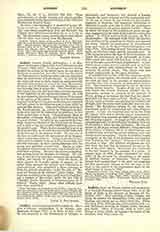

Jouffroy , CLAUDE-FRANVOIS-DOROTHÉE DE, MARQUIS D’ABBANS, mechanician, b. at Abbans, near Besancon, September 30, 1751; d. at Paris, July 18, 1832. He was educated by the Dominicans of Quingey in philosophy and literature, but showed a leaning towards the exact sciences and the mechanical arts. At the age of twenty he was enlisted in the infantry regiment of Bourbon, but numerous infractions of discipline brought upon him in 1772 the punishment of confinement at the prison opposite Cannes. There he began the study of the problems of steam navigation, suggested by the sight of the convicts rowing the galleys. In 1775 he went to Paris to study the Watt steam-engine. He discussed with Fierier the application of steam to the propulsion of vessels, and opposed his views. Finally he constructed an experimental boat, and ran it on the River Doubs during June and July, 1776. The system he used then was the palmipede, or web-foot, which proved unsatisfactory. In 1781, being promised the help of the Government, he began the construction of his pyroscaphe at Lyons. This vessel was about 140 feet long, 5 feet wide, 3 feet in draught, and 150 tons in displacement. A horizontal steam-engine moved a double rack to and fro; this rack geared with ratchet-wheels on the shaft carrying the paddle wheels. The wheels were thus turned continuously in the same direction.
At a public trial, July 15, 1783, the vessel ran up the Saone at Lyons against the current with a speed of six miles per hour, in the presence of representative scientific men and thousands of enthusiastic spectators. This steamboat continued to run on the river during sixteen months. In spite of the very favorable report the French Academy withheld its endorsement, perhaps on account of the jealousy of Périer, giving as an excuse the fact that the experiment had not been made at Paris. Jouffroy, having already spent a fortune, was too poor to continue the struggle, and the guaranteed monopoly was not confirmed. The Revolution setting in, all work was abandoned until the restoration and after Fulton’s success. A boat was launched and run on the Seine August 20, 1816, and at last the patent was granted. Still Jouffroy was opposed and failed to get the necessary financial support. At length in 1831, utterly discouraged and poor, he retired to the Invalides, the home of old soldiers, where he died of cholera. He was admitted to the home without difficulty, being chevalier of the Orders of Military Merit, of Saint-George, and of Saint-Louis, and having served eighteen years and during eleven campaigns. Claude de Jouffroy fought constantly on the side of the legitimists and opposed even Napoleon, the “usurper”, refusing to submit his invention to him. His religious sentiments are evident from the fact that he entrusted his son to the care of the Abbé Blond. He himself was comforted to the last moment by the presence of a priest. A century later, in 1884, France recognized the originality of the inventor by subscribing to the statue of Jouffroy erected at Besancon. Robert Fulton himself had testified that “if the glory (of imagining the first pyroscaphe) belongs to any one man, it belongs to the author of the experiments made on the River Saône at Lyons in 1783”
WILLIAM FOX

